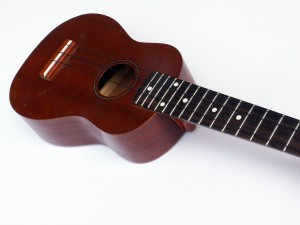The Ukulele: A Short History
When I think of the Hawaiian Islands one of the first things that comes to mind is a relaxing vacation on some sun drenched beach; Hula dancers- a refreshing drink – and of course the sweet sounds of ukulele(s) being strummed into the sunset. Classic, right? Well, as classic and classy as the Ukulele can be and is to Hawaiian music culture and now the world, it turns out the structural origins of the Ukulele isn’t indigenous to the Hawaiian Islands. No, the Ukulele’s background and basic construction, if you will, has mixed roots originating in another place drawing inspiration for its design from two instruments of this country.
Pre Arrival (Ancestry)
Our present day Hawaiian ukulele was basically born out of two Portuguese string instruments: the Braguinha and Rajao, (one considered a solo instrument, the other a caring the rhythm role in a group setting), both popular string instruments from the island of Madeiran and mainland Portugal respectively, brought to the Hawaiian Islands to where the Ukulele drew it’s shape final tuning, and attitude.
The Journey
It was 1879 when the ship Ravenscrag left its port from Maderia Island (an autonomous region of the Portugal archipelago) filled with immigrants in search of work in a new land. Among the many contracted field workers immigrating in were, three cabinet/woodworkers later to be instrument makers: Manuel Nunes, Augusto Dias and Jose do Espirito Santos, directly responsible for transporting and instrument(s) believed to be the Braguinha/Machete and Rajao both of which would serve as the main palette and final formation of the Ukulele we know today. Also aboard ship was Joao Fernandes who displayed his talents by entertaining the native Hawaiians when they arrived in Honolulu.
The Arrival and acceptance
Within a relatively short period of time gained acceptance from Hawaii’s royalty accomplished musicians: King Kalăkaua, Queen Emma and later Queen Liluokalani played and performed with ukulele bringing it to Hawaiian’s a rapid pace and delight to all.
Of the three cabinet make Dias is noted to have opened a shop in 1884 and Santo and Nunes and sons opening shops a few years later.
We find ukuleles showing up in expositions in Chicago and San Francisco from 1893 and musicians using the instrument in the acts and shows in the mid west and along the eastern seaboard
Pronounced ‘Oo-ka-lay-lay by native Hawaiian’ s and given the nickname the jumping flea- referring to how the fingers moved across the neck of the UKulele continued to grow.
When it comes to popularity the Ukulele has had its share of ups and downs: With its showing at the Panama- Pacific International Exposition in San Francisco in 1915 the Ukulele would grow to mass appeal by main land America subsequently opening the door to larger instrument makers; Martin, Harmony, National, Gibson….to name a few, increased production bring the ukulele to a wider audience and continual growth was and even consider the most popular instrument in the world. During depression of 1929 and the war that followed was a slowed production and interest for the Ukulele and with a growing popularity for guitar… But with the help of actors in the 50s and educators the uke did gain more momentum and grew he ever more in the 60s with the help musicians George Harrison of the Beatles. However in the 25 years with much help from Internet, youtube and the help from such players Jake Shimabukuro, the late Isreal Kamakawiwo’ole, kalie Gamma, Brittni Pavia… A new light has been shed on the ukulele today.
Uke-Addicts Tips and Tricks

1. UKE OVER HEART HOLDING POSITION (Uke allegiance position)
Whether you are standing or sitting, finding a suitable position to hold the ukulele will go a long way in terms of comfort and ultimately increase the amount of time one can practice and perform – which all translates into your sound and your ability to shape it to make beautiful music! Here’s one way to help get you in the proper playing position regardless of whether you’re standing or sitting :
Try This:
STAND up; hold UKULELE IN THE RIGHT ARM, HEAD STOCK pointing DOWN towards the ground. Make sure to face uke strings away from your body (right leg) with hand clasping the uke where the neck meets the body with index finger straight. Right arm should be extended straight down. Next bend your arm up – with uke-ACROSS YOUR CHEST AS IF putting you hand over your heart. There you go!
“Finding The Sweet (sound) Spot”!
Although small in its stature, the general sound production of the Ukulele isn’t short in its ability to bring different tonal shades and colors to a listener’s ears.
And if you’ve experimented with strumming different areas along the neck of the uke, you’ll find some interesting results; textures and tonal changes open the instruments sound palette, and with a little dynamics you’ll find a small orchestra in your hands to build your next masterpiece. However, with all the possibilities that brings, uke players still have one place they favor over other areas of the neck. One that is inadvertently loved by most uke players, which strikes a balance in terms of high, low and the mid-range, and, overall balance, especially when strumming their ukulele. That area is what we call the The Sweet Spot! And the best way to find that Spot, is to follow you Ears.
Here’s how to find “The Sweet Spot” on your ukulele:
First, find where the neck meets the body of your ukulele. Then strum the strings from that area down (towards the tail end of the uke) to the sound hole and listen for the most balanced place; where all four strings come together, where all the strings really sing; where one string isn’t over powering the other…
The Sweet Spot lives in that small area, whics will vary a bit on each ukulele, but this is where most uke players spend a good portion of their time strumming.
3. IT’S ALL IN THE WRIST!
Relax that wrist, baby!
Now, for the average uke player most will begin strumming downward with the thumb right hand (of course the opposite if you’re a left handed player) thumb with all down strokes. However, to increase your tone and to add different textures try experimenting with upward (towards the sky) strums with the thumb as well as other fingers- index or pointer finger is great next choice – to bring your playing to the another place musically. Brush down lightly at first- using your nail to strike the strings. Then work on playing with dynamics (loud and soft) strokes. With regular practice you’ll find that your strumming will hold many new areas to explore rhythmically.
1a)***USING THE INDEX FINGER…
After you are comfortable with strumming with your thumb practice playing with a relaxed right hand wrist when strumming. Strive to keep your hand relaxed while strumming over the fretboard of the Ukulele.
——————
Since most of you have probably heard of young virtuoso ukulele player “Jake” Shambukuro I’d like to start the recommended Uke-Addicts listener list with three players you may not have heard of; one is a legend and two young stars on the Ukulele scene today. You can find videos on youtube to uke your listening appetite.
1) Otha-San or The Legendary Herb Otha.
2) Kalie Gamiao
3) Britain Paiva
